The Genome Sequencer FLX (GS FLX) system is the second generation of the Roche 454 sequencing station. The GS FLX is named after its flexible application in many fields . With the system performance and continuous improvement and expansion of application fields, it will bring the whole dynamic technological development in the field of sequencing, a tremendous role in promoting applied research related to large-scale gene sequence. With advanced Roche 454 high-throughput sequencing platform , professional research team and personalized experimental program, Meiji Bio will create high-quality high-throughput sequencing services for you.

Genome Sequencer FLX System
Model: GS FLX System
Reagents: long-read GS FLX Titanium chemistry
Production: 1 million serials ∕ Run
Reading length: 400bp or more
Applications: Genomic de novo sequencing, transcriptome de novo sequencing, metagenomic sequencing, resequencing
Contribution: 1026 academic papers have been published using this technology
Development: In 2011 , the sequencing read length will reach 1000bp.
Sequencing principle
The sequencing principle of the GS FLX system is based on pyrosequencing, which relies on bioluminescence to detect DNA sequences . The synergistic effect of a DNA polymerase, of ATP sulfurylase, luciferase and dual phosphatase, GS FLX system was polymerized with a primer on the release of fluorescent signal of each of the dNTP conjugated together. The purpose of determining the DNA sequence in real time can be achieved by detecting the presence or absence of fluorescence signal release . This technology does not require fluorescently labeled primers or nucleic acid probes, nor does it require electrophoresis; it has the characteristics of fast, accurate, high sensitivity and high automation.
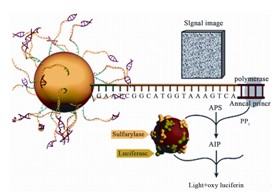
Schematic diagram of GS FLX high-throughput sequencing method
experiment process
 | The GS FLX system reduces the reliance on large automated stations during traditional sequencing sample preparation , eliminating the need for cumbersome database construction, cloning and microplate processing, and utilizing innovative magnetic beads and emPCR technology. Sample preparation is performed while providing a complete follow-up bioinformatics analysis solution. 1) Sample type: GS FLX System supports a variety of different sources of measurement sample sequences, including genomic DNA, PCR products, BACs, cDNA and RNA and other small molecules, different types of samples can be done on a sequencing instrument. 2 ) Sample DNA disruption: Samples such as genomic DNA or BAC are interrupted into fragments of 300-800 bp ; for small non-coding RNAs , this step is not required. The short PCR product can be directly amplified using GS fusion primers and subjected to step 4) . 3 ) Adding a linker : A pair of specific A and B linkers at the 3' and 5' ends are ligated to the DNA fragment by a series of standard molecular biology techniques . Linkers will also be used in subsequent purification, amplification and sequencing steps. Only the single-stranded DNA fragments to be used in the subsequent steps are shown in the figure . 4 ) A DNA fragment = a magnetic bead: a linker allows hundreds of DNA fragments to be bound to a magnetic bead, respectively, and the magnetic beads are coated with a single oil-water mixed droplet, and then independently amplified in the droplet. There are no other competitive or contaminating sequences ; all DNA fragments are subjected to parallel amplification (emPCR) . 5 ) One magnetic bead = one read length: After emPCR amplification, the DNA fragments on each magnetic bead have thousands of identical copies. After enrichment, these fragments are still combined with the beads and can then be placed in Pico  Titer  The Plate was used for subsequent sequencing. 6 ) Data reading and analysis tools: The GS FLX system provides three different bioinformatics tools for analyzing sequencing data for different applications . For example , resequencing of up to 3GB sequences, analysis of amplification products compared to known reference sequences, and de novo sequencing of 120MB . |
Technical application
Whole genome sequencing
u Sequencing up to 120 Mb of unknown genome
1) Generate a genome structure overview
2) Study the organization, distribution and information of DNA sequences
3) Genetic screening: finding new genes, positioning and function
4) Comparative study of other genomes
u Whole genome sequencing by de novo shotgun sequencing, such as microbial genes, BAC and YAC clones
u comparative genomics research
1) Identify single base mutations
2) Identify mutation hotspots and conserved regions
3) Identify inserted or deleted genes
4) Determine the relationship between genotype and phenotype (such as the genetic basis of research drug resistance)
5) Toxicity prediction based on genetic sequencing changes
6) Conduct epidemiological analysis
7) about the differences in the industrial production strains and their parent strain as a genetic sequence based development of industrial production strains
8) perform metagenomic (Metagenomics) study
9) Ancient fossil DNA sequencing research
The method of using the paired end u (Pair-End Tag) Scaffolds spliced into the Contigs
2. Transcriptome and gene regulation studies
u based high throughput transcriptome short Tags, ESTs, ChIP or GIS-PET sequence analysis, or genome-wide miRNA sequence identification, small molecules and non-coding RNA sequencing
u Study DNA methylation patterns for gene regulation studies
3. Analysis of amplification products
u Hyperfine sequencing of PCR products (for resequencing in medical research)
1) Identify somatic mutations in mixed tumor samples
2) Discover high-reliability SNP sites at the population level
u Deep analysis of environmental microbial species diversity
Technical advantages
2 Genome Sequencer FLX Titanium Series
The GS FLX sequencer uses the upgraded Titanium series of reagents to achieve breakthrough second-generation sequencing that ensures high quality, high read length and high-throughput sequencing for each sequence. Widely applied and stable, he has published thousands of academic papers in the fields of genome de novo sequencing, genome resequencing, target gene capture sequencing, metagenomic sequencing and RNA sequencing analysis.
Each run can generate more than 1 million valid sequences, with Q20 as the criterion, and single-sequence read lengths above 400 bp take only 10 hours.
2 Improve project implementation capability
Using the GS FLX platform, the perfect combination of long sequence read length sequencing and large fragment double-end sequencing can be achieved in one experiment , and a micro-genome de novo sequencing project can be completed in one experiment , and the best splicing effect can be ensured.
2 reduce the cost of experiment
The read length and ultra-high-throughput sequencing capability of 400 bp or more maximizes the experimental results and minimizes the experimental cost. The sequencing flux can be flexibly selected according to the experimental design requirements, ensuring the full utilization of the sequencing capability and realizing the experimental saving.
2 improve the efficiency of the experiment
The library construction process for standardized flow-through operations avoids bacterial transformation, culture, and monoclonal selection in routine experiments. The emPCR enrichment of the fully automated workstation frees the experimenter from cumbersome experimental operations. 2 provides easy to use biological information processing software
Provide bioinformatics solutions
Such as GS De Novo Assembler , GS Reference Mapper , and GS Amplicon Variant Analyzer , the processing of sequencing data is handy.System property
l Titanium series reagents
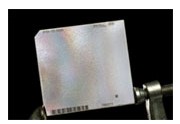
The Titanium range of reagents is optimized for reagents, consumables and software to ensure superior sequencing performance of GS FLX .
GS FLX Titanium series performance
| Throughput | 400-600 million high-quality , filter-passed bases per run* 1 billion bases per day |
| Run Time | 10 hours |
| Read Length | Average length = 400 bases |
| Accuracy | Q20 read length of 400 bases (99% at 400 bases and higher for prior bases) |
| Reads per run | >1 million high-quality reads |
| Data | Trace data accepted by NCBI since 2005 |
| Computing  Requirements | Cluster recommended (Roche GS FLX Titanium Cluster available) |
| Robustness | No complex optics or lasers , reagents have long shelf life |
Examples of sequencing results: (average read length, number of sequences depends on sample characteristics)

GS FLX Sequencer
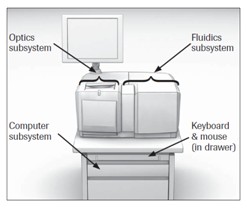
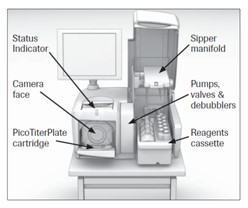
Sequencer full picture sequencer internal structure
l GS FLX high-throughput sequencer specifications
| Dimensions: upper assembly | 74.3 cm W × 69.8 cm D × 36.1 cm H |
| Dimensions: lower assembly | 75.2 cm W × 90.8 cm D × 92.7 cm H (29.62 in W × 35.75 in D × 36.5 in H) |
| Weight | 242 kg (532 lbs) |
| Power supply | 85 - 132 Vac 50/60Hz 173 - 264 Vac 50/60Hz |
| Noise level | <65 dB(A) |
| Electromagnetic e mission | Class A |
Electromagnetic immunity | Important: In industrial areas , this device may be influenced by radio interference. The user should take the necessary precautions , if appropriate. |
Performance improvement
In 2011 , the GS FLX Titanium series of reagents will be upgraded, and the sequencing read length can be increased to 1000 bp , which exceeds the sequencing read length of ABI 3730XL , which greatly broadens the application range of GS FLX .
★ 1Kb read length combined with 20Kb , 8Kb and 3Kb Paired end sequencing, the complete sequencing of the genome de novo can be easily achieved .
★ When performing transcript sequencing, the 1Kb read length sequence can detect more exons and alternative splicing regions and find more gene subtype information.
★ Long sequences can be associated with more distant variation information, which is more conducive to typing analysis .
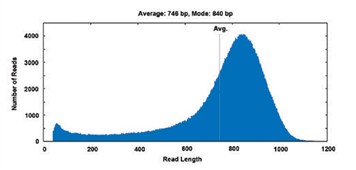
The average read length of the sequence reaches 746 bp , and the read length is around 840 bp .
Contact Meiji:
High-throughput sequencing technology service phone
mailbox:
Website:
113G Curry Powder Plastic Bottled
Types Of Curry Powder,Curry Powder Coles,Curry Masala Powder,Tikka Curry Powder
jiangmen city hongsing food co., ltd. , https://www.jmhongsing.com